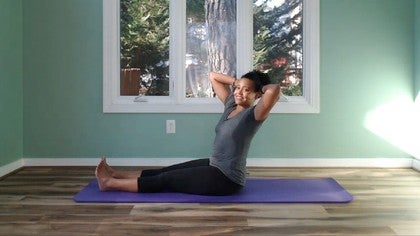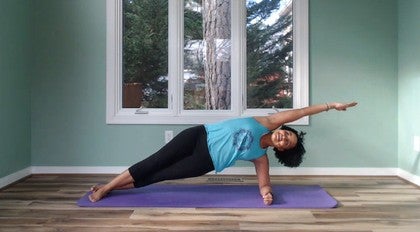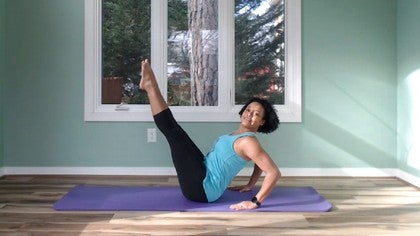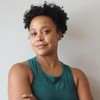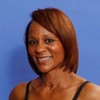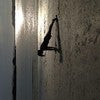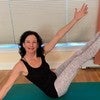Description
About This Video
Transcript
Read Full Transcript
Hello everyone. Good morning, good afternoon, good evening. Today is the third day of the Rise and Recharge challenge with Pilates any time. I'm Danica and today we're gonna be talking about articulation. Now, right away you're probably gonna think spinal articulation, and you are right.
I do mean spinal articulation. However, I also mean how joints are supposed to articulate naturally, and by what the textbook says the joint should do because no matter what we're talking about in movement, a hinge joint is a hinge joint. A gliding joint is a gliding joint. They have specific ways that they should move. And when that articulation is disrupted all kinds of things go crazy, okay?
So we're actually gonna start lying down with a little bit of pelvic clock, pelvic curls so we can start waking up the lumbar 'cause it's still morning for me. So go ahead and lie down. Bring your knees over toes, toes under knees. Feel your heels in line with your sits bones. Try not to be too wide.
So you're still more gathered in towards your midline then in line with your outer hips. If you really want a little bit more oomph you can make a little bit of a frog and bring your feet together which has been causes a little bit of external rotation in your thighbone. Play with that for just a second. If your feet stay apart and you keep space in between your feet, or if you find a little external rotation of your femur and it draws your feet together and makes a seam in your feet. What makes you feel more life back up underneath of you?
Choose and decide and go with that. Now, pelvic curl, leave your ribs on the floor. Take a deep breath in. And as you exhale, find that engagement of the back if you lift and press up out of the floor, giving some flection in your lumbar spine and a little lift and lightness of your sacrum, and then exhale roll back down, and really feel your pelvis finish its articulation back to neutral. And then we're gonna go to the hyper extension of your pelvic movement.
Tip your tailbone down. Tip your pubic bone down. Let lordosis happened. Let your ribs flare, let it happen. Breathe in and as you exhale, pull your pubic bone back up.
Find the back of the legs engaged. Find that press up out of the mat curl but still hold those ribs down. Pelvic curl, just entices your lumbar to get in the mix. Your thoracic spine can stay nice and tall. Coming back down.
Don't stop in a tuck. That's telling your hip flexors to stay really grip. Let your pelvis roll on the ball of the femur. Let it keep going. Let it entice some lordosis and it will kind of pull you down the mat.
That's okay. Curl the tail, pull up your pubic bone. Feel it push you back up tall through an active neutral. And then back up into that little curl. Now you're gonna stay in that little curl and you're gonna let your pelvis tip over to one side and let it roll you down that side of your back.
And then you're gonna pick up that side of the pelvis. Pick that side of the back up and then level yourself. Give a small rotation in your lumbar. Let it roll the other side of your low back down to the floor, down to the pelvis and then curl back up that same leg up. Pick up that same side of your back, back center.
Roll back down through center. 'Cause already that should have woken up your hamstrings. If you need to give them a little shake out, readjust if you need to. So you're gonna curl up through center and then you're gonna take a twist over to one side and let that low back and pelvis touch the map. And then you're gonna scoop and lift it back up and level your pelvis back off.
Let an easy rotation happen over to the other side. Pelvis comes to the floor, scoop it up. You're gonna hold it up and now we're gonna go all the way around town. So over to one side, pelvis touches the floor. Now keep letting it come to the floor.
Keep letting the other side of the pelvis come to the floor. Tail tips down, you're in that lordosis. You tip weight over to the other side and lift up the other side of your back level off its center, reverse it. So I'm twisting to the left. I'm gonna roll down the left side of my back.
I come through a little tuck and then I'm gonna let my pelvis reach, let it pull my back into a new place. And then I'm gonna curl up the right side of my pelvis, right side of my back, lift back up center. And it doesn't need to be big. One more, it could be as small as just a little bit of pelvic circle and you don't even really need to lift your hips off the mat at all. And try the other side.
Find a range that actually makes you feel the fact that your spine is articulating lumbar and all around your pelvis. Last set, however big or small you want it. Don't try to control your rib cage. Don't try to control your shoulders. Just let bone slide around because you are actively moving them, shake it out.
Find center, find an even weight on your pelvis. And now organs are gonna come up into those shoulders. Lift both arms up, find the ceiling and now take a deep breath in. As you exhale and let the arms reach back, make the choice to allow the way to the arms to fall with space, which should make your ribs arch and feel that thoracic extension that's trying to beg you into swan but the floor is in the way. On an exhale gather the abs, pull the rib cage back to the line, bring the weight of those arms up, and roll the arms back into.
Now we could call that hanging on your joints. You just take your arms back there and hang, right, feels good. But if you have to lift up from there, kind hard. So now keep your ribs gathered, reach back and stop the arms where they stay connected to your mid back, mid ribs, down into the ground. Exhale, bring them back.
Now you're isolating the articulation actually in the ball and socket of your shoulder. Roll the humerus. Let the shoulder blades slide. Let them go where they go, but let the humerus roll in differentiation from your thoracic moving your rib cage and then back down. One more.
Every action that happens in a ball and socket joint is a rolling action. Whether it's your arms rolling or your thigh bones rolling. It's a rolling action. Place those arms down by your side. Give it one more curl up from your hips.
Just to let your feel yourself tall and stand up into your shoulders. Little shoulder bridge if you want to. Bring it back down, find your neutral. Let your feet come apart. So you really are in your parallel now.
And in your parallel we're gonna take a little knee fold. Now, even though I say knee fold, that's really not what I mean. What I mean is roll the thigh bone and the pelvis and engage your hip flexor to pull your knee to your chest. Yes, you have to use your hip flexor to flex your hip. So therefore now you gotta find the back of that hip.
If you just let gravity drop, you're gonna move. Pull the back of the leg back down. Stabilize, don't move what doesn't need to move. Other leg. My knee totally comes towards me, comes towards my chest, comes towards my forehead but it's a real roll of the femur and the pelvis.
Set it back down. Now, pull one leg to your chest and then keep pulling to the point where it actually takes you into that pelvic curl and curls your tail and lets your low back lengthen and come into a little bit of flection. Know that that happened. Roll back through that low back back to your neutral and then set your leg down. Don't let yourself go to that hyperextension.
Other leg, pull it in and know when you have finished articulating inside the pelvis and then begin to articulate joints of your lumbar. Retrograde that, reverse it, go straight backwards. Go through the lumbar, ground the pelvis, and then back down. One more each side. Just test that out for yourself.
When does it become articulation of other things? And choose to let that happen 'cause you're in control. This is all voluntary, right? Choose to let that happen. Bring it back down.
And now here we go on a little bit farther. Pull a leg up. Now as you stretch it to the ceiling, you add the knee, right? Now, add the ankle, give it a flex, give it a point, two more flex. Give it a point.
Stabilize, back against it, flex. And point. Give it a circle. All around town. Do not move your femur bones, just the foot. Articulate all of those little gliding joints reverse in your tarsal bones down there.
There's all this happening in your foot. Let it. And now even just give it a shake. Just shake it. And when you shake it, let everything else shake and then given to gravity and just let it fall.
Let it fall and feel like it just humming, right? It's just humming. Other leg. Stabilize. Get up tall, take a breath in, exhale, fold it up press it up just to 90. And if it doesn't get straight, it doesn't matter.
You can still flex and point your foot with a bent knee. You can still have a strong leg with a bent knee. If you've got tight hammies, tight anything, you can still be strong. Circle it through either ways. And yes, I don't know if you hear it but my foot is going like snap, crackle, pop pop.
Reverse it, right? That lets me know if things are moving, at least, right. Sound effects (laughs). And then give it a shake. Give it a shake, give it a wiggle and feel it letting it even slide your muscles around.
If you're not using them, they should be loose. Set it down. Right. Now we're gonna take a little knee fold leg extension. Fold, pull. Then let the leg slide out on the floor, reach it long, and then lift it up with a straight leg.
Bring it back down. Fold it in, same leg. Stay on the same leg, reach it down out, lift it up and keep it easy. Don't try to kick yourself in the face. Don't try to be a rocket, right?
Reach it out. But hold your spine tall. Hold your spine still. One last one. Pull it in.
Reach it out. Lift it up. So that really kept all the articulation in my leg, knee and my hip and my knee and my foot. Other side. Fold it in, spine stays tall.
Reach it out. You've gotta engage to support your back to lift the weight of that straight leg. Fold it in. It's a lighter leg when it's bent. It's a heavier leg as you lift and pull and yeah, you notice you need your standing leg, the leg that's still on the floor, helping stabilize and stand you up.
Last one, lift, keeping your back tall and let it lift up. Now you're gonna do this set one more time except now you're gonna let yourself rock. You're gonna let yourself feel how the other joints can move with. Pull in, let it reach out. Let it feel a little sloppy, lift up tall and back down.
Just two more, lift it in. Let it fall and rock. Let it lift up the mat. Let yourself kind of go with it one more time. Just so you realize there's a lot of joints.
Let that leg settle down. Three the other side. Pull it in, let it rock, lift. Set it down and we'll pull it in. Let it rock.
Let it roll, lift, and set it down. One more lift and set it down. Bring it in. Take a breath and notice that there's just kind of this hum going on around your low back, around your hips. Let yourself give a little sway side to side.
Let the weight of your legs help with that. So their knees can break plain and just kind of shift and shimmy a little bit. Let all that just kind of shake any kind of weird feeling out of your low back. And then we're gonna let your legs melt down and open. Reach your arms up over your head.
And now you're in your magic X again that we were playing with yesterday. And in this magic X, I want you to reach your right hand across your chest, up over to the left fingertips, and feel that you wanna pull the upper back, mid back, low back and feel the rolling of your joints. Reach pull back through that diagonal down to the foot, pull yourself back through your waist, retrograde your articulation. So if I'm gonna start with my fingers, left fingers, reach up over cross and I'm gonna reach and find a diagonal to my left toes. Initiate with left toes, pull back, feel each joint articulate from the other direction in space.
Start with your right leg, pull it up over, let it cross down across your midline, which you're gonna use in single leg circle in a little bit crossing across that midline to get a pull and stretch of your outer hip. Retrograde, pull back up through the arm. And then your left leg. Pull it up over and end. And it's like, good morning.
I feel all my joints moving. There can just be this nice glide slide and ripple through everything. And now on an exhale I want you to find that initiation of your abs. And as you pull in, feel it roll the arms. Feel it roll your thigh bones, articulate everything.
Tuck up into a little ball, squeeze squeeze, squeeze, squeeze, squeeze. And then as you push head and tail away from each other let your femurs dropout heavy. Let your arms reach out tall and exhale. Contract, pull and tight little ball. Give yourself a hug.
Let it curl your tail. Let's find yourself in some spinal flection and then reach back out and let your spine move back out. One more of those. Pull in, tight into your tight little ball. Hold your tight little ball.
Hold your tight little ball. And then stretch both legs out. Reach your arms down by your side. Just go into your hum and breathe and exhale. Breathe in and exhale.
Just do three more breaths here and exhale. Let the moving of your arms in the socket challenge you to hold the rest of the shape still. Last breath. And then you're gonna pull your knees back into your chest, tuck it in, give it a good curl. Let your tail curl up and reach it back out to the side.
I mean out to your X, big X. Now give it a little bit of hello. So you're not completely hanging out but don't force yourself into a straight back, right? Just like, okay. Now you're gonna find your sides.
You're gonna find your sides. You'll all bleak leakies, right? And I want you to pull ribs and pelvis together on one side, let it pull knee to elbow, elbow to knee. And you're in this like side bend side flection thing and then push yourself back out. 'Cause your spine side pulls to the other side, pull elbow, knee together.
Let it pull your head around. Let it feel like it pulls your tail over and back center. Keep going, your spine has to be able to flex extend, side bend, and rotate. So find how those joints move into the side. Articulation isn't always about curve up curve down, roll up, roll down.
You got to be able to reach around and over and contract the old leaks on one side, lengthen the other, and stretch back out. Now think of those obliques. Now coming with you into center, as you exhale, pull back open to that ball curve, curve, curve, curve, curve, curve, curve, and send both legs out again. Five breaths for your hum and breathe in. And breathe out and breathe in.
You've just moved your sides and your side body is still part of your core. So how is your side body helping lift and pull? Woo even though you're a neutral and not side bending, two more breaths. Think I lost count. So much for that New Year's resolution of counting.
And then you're gonna pull your knees back into your chest but you're gonna go right back into your roll up. Let yourself just stretch out the legs. Let yourself come over and round over. Now, go ahead and put your hands on your feet. If they don't make it there, put them on the floor next to you, but give a little push, give a little push.
And when you give a little push you can put them on your shins. Just put them anywhere. When you give that little bit of push, exhale deep and abs back. And if you can't feel that, right, if you can't feel that, then you're too far forward. Come back a little bit, come back a little bit, come back a little bit, right?
Scoop and pull. Just because your hamstrings may be long, you going all the way over without any ab support, isn't a roll up. That's just the hamstring stretch. And if Joe wanted to call it a hamstring stretch you call it a hamstring stretch but he named it the roll-up right? So here you are.
Oh, see, now I really feel it. I was just hanging off my hamstrings, truth. When I start to roll back the first joint to start moving is not my lumbar spine. It is why I do not queue initiate and pull back belly button because that's not the first joint to move. First joint to articulate should be the pelvis on the femur, right?
The socket on the ball. So press with legs, press with arms, feel the pelvis start to initiate and articulate and then find the lumbar. Then find thoracic. Let your arms just stay down by your side. And then they're gonna reach up.
And today they're gonna circle out to the side. So you actually feel that rotation of the arms and the socket. Let it squeeze you into center, peel you up. Do whatever you want with your arms. If you wanna lift them, lift them up by your ears.
If you want to press them back into the floor, press them back to the floor, but get that core work. Get that cool scoop going on. Don't make it about, oh, look, I can my lick my knees. No, make it about, I feel strong. Curl your tail first.
Don't fall back. Curl tail, articulate and see it in your mind. The suck it rolls on the ball, right all the way down. Arms, reach back, circle around, help pull you into your center, bring you up. Again, do your own arm choreography.
Let it help you. Let it make you feel that pull back but make sure it also makes you feel the articulation. Each little bone should move. Also the movement of the arm and the socket. The arm does not fall up into the neck.
It stays in the socket, reaches back. Two more, inhale. Exhale. Reach in and get the way to that mid back. You should notice now that is real heavy.
Mid back, base of the ribs, super heavy. Roll down, curl the tail. Let the arms being strong in your back. Help hold the way to your mid back, circle the arms when you come back. Staying up on this one, exhale over reach, reach, reach, reach, reach, get a little stretch.
Hands back into the floor, press one hip forward. Keep both sits bones on the floor, slide one leg forward and let it feel a spiral. Wanna creep up your back all the way as far up into your neck as you want it to go but keep ass sits bones on the mat, curb and then come back forwards and the other hip forward. These are one of my favorite things to do in the world. I mean, I do it all the time watching TV, just kind of floss your back.
It's so good. One more each side but it makes you feel how muscle should articulate. Muscle needs to be able to move. Fascia needs to be able to move like your whole moving grooving organisms. So move it all.
And then you're gonna come forward on the mat, stay seated. Great. Pull soles of the feet together, press. Now if this bothers you and you've got yoga blocks near you, prop your knees up on some yoga blocks or something, or you could also hold underneath your knees. I do not recommend sitting criss-cross applesauce because there's your pelvis is gonna be unlevel on some way.
If you do sit this way make sure you sit the other way for as many reps But soles of the feet together is where I actually feel uniform and press together. It's not hanging out to the sides. It's into, that idea of like crab and advance mat. Up tall. So we're gonna talk articulation. You want to initiate from one end of the spine or the other.
If I lead from the top of my head, allow my chin to come to my chest, I can close the ribs. Keep on curving forward. You go through 100 and you hear it ask your lumbar to start to bend. Now, keep your sits bones grounded. Stack back up.
Standing down in the tail, feeling one bone at a time. And here's what I like to call the drama where you feel your upper back pull your chest and collarbone open before you pick your head back up. I call it the drama because people love to skip it, right, growing over again. You feel the drama. For some of us, this might be huge stretch up through your cervical and out through your shoulders, contract, but keep your sits bones rooted.
Don't let your pelvis move yet. Curve over and you hear your mid back, oh, that's as far as you goin' if we're not gonna move your pelvis, and you say, okay. And then you pull abs backing up. And as you scoop up, don't be so quick with your head. Articulate that upper thoracic, feel the drama pick your chest up.
And then the head. Now one more. This time, exhale. Find the conscious moment where you say to yourself, huh, that's like all the thoracic lumbar fluxion I got unless my pelvis begins to articulate and dives me forward. And it rocks you forward on your sits bones and it may open your knees more.
But keep 'em pressed. So you're still alive in your bum under there because now I can't just pick my head up. I wanna pull my sits bones back and articulate back on top of lumbar thoracic, find the drama and then your head and you can pull to get your drama. You have arms. Don't feel like they're just hanging out.
One more of those. Curve forward. Curve forward and find the moment your pelvis actually decides to go forward. Right now, pull it back on purpose. Stack back up on top of it.
Use your arms. Find the drama, lift up through the chest. Now stay up tall. Now that was fluxion. What if you keep taking the head back?
Look up towards the ceiling and pretend someone's calling your name back behind you. And lift your chest up. Hello, you're in swan and exhale. Pull that back center. Stay on top of your sits bones, inhale lift.
So staying on top of the sits bones makes me have to go up, open the chest even more, pull onto the knees to help support that opening. And then come back up. Now try that two more times. Here's the next little part if you want. Comin' up, this is a little bit of a challenge, to go back farther I'm not gonna back bend anymore.
I'm gonna open the front of my hips and pull my pelvis back. Pelvis pulls back. I'm holding on for dear life with my arms. Trust me. And then I'm gonna think abs gather and that reaches in and pulls me back forward and back up.
Try that one more time. Lift up tall. If you're like, we're good here, then be here, breathe. It's not viable if you can't move air. If you want a little bit more challenge, not back then more, but from the pelvis, let yourself go back and reach back.
Opening up your chest. Gather and pull pelvis comes back. You come back. That was a lot. Hello, swan, right?
Take one more curve forward like we would do, after like long box and you're like, oh, your back's on fire. Well, it should be. Stacked back up. Give it a wiggle. Everyone loves a wiggle.
While we're here, we should probably do some tree. Mm-hm. Right. Stretch both legs out. Lies. Slightly bend them. Slightly, slightly, slightly, slightly.
Flex your feet, dig your heels and give them a little pull. So it shortens up the back of your thighs and you got a little concentric going on in these super long muscles up your posterior leg. Pick your favorite leg. You have two, pick your favorite leg, get both hands underneath of it. Now keep the other heel nice and strong.
Pull knee towards your chest. Foot can still stay on the floor. Find the moment where you get in your own way. And you start to collapse. That is when you decide to open up the front of the pelvis and lean back, which you can have some push off that leg that now wants to get straight.
Get that heel in the floor. You can also give a little curl. Today I'm gonna ask for a little bit of curl, not round, I don't want a big stomach massage rolling like a ball curve. I want a super, super, super capital case. Super, super capital case.
Leg stretches up. Use the strength of your arms to hold your back up, not your traps, your whole arm. Bend and stretch it up and bend it back down. And one more, stretch it up and bend it back down. Keepin' foot on the floor.
The leg that hopefully now worked its way to straight, lift it, set it back down, right? Figure out where your torso needs to be. Flat back, little bit of curve, whichever one, but figure out a lift where you can still articulate and the flection of that other hip, lift. If you're finding a hard time with that, you're probably collapsed into the front of that hip, lift. And now back to that bent knee tree leg again, straighten it back up.
Now you're gonna not fall back but you're gonna climb, reaching the back of your head over your toes. Climb, climb. Now, you're actually gonna rock forward, rock forward. You're not gonna let that leg touch the floor and notice how you want to kind of get some crunchy wonky thing going on in your back there. Lift, fight, pull. It doesn't have to be pretty.
It just has to be a challenge. Rock back, your goal is for that leg to hit 90 without picking up the foot on the floor. Goals. Rock back forward Uh-huh. One more, rock back. All right, this is just hard.
It's supposed to be. Here we go. Climb down the tree, pull the lumbar back, keep rolling in the hips. The next bone. Keep rolling, now keep those abs contracted to keep you nice and controlled into the mat. And then you're gonna reach your arms back.
Circle them around, grab back a hold of the leg. Pick up the head, climb, climb. The goal is to keep the leg 90 and you climb the leg, but you know what? Rock forward to let leverage help you if you need to. And then we walk down the leg, right?
Where you are is where you are. It's gonna be hard no matter what. Reach back, arms around. And as you peel and articulate up, at what point do you have to let your pelvis articulate on that other leg to help you come up? Yeah, you can't leave your pelvis back there if you want to come all the way up, right?
If you want to climb the whole tree, right. Go ahead and bring that leg down though. Shake that out. Let's do your other side. So it's like you get both sides on before we do your single leg circle.
So bend the leg. Start with both knees, bent heels digging. That's really how you start. So you're aware that you're awake still in your legs. Grab a hold of that other leg, pull it in.
And as you get it closer to you, not necessarily up off the mat, but just closer to you, notice where you have to start making allowance. And if you can start getting that other leg straight, do so. Straighten the tree leg, bring it down. Straighten the tree leg, bring it down. Straighten it, bend it, keep it bent.
Find the leg on the ground. Can you have enough lift? Pick it up. I am pushing down with this leg. Don't feel like this leg is not doing anything.
Lift. And up. But notice how you could make it low back. Find the joint you want to articulate and do the thing there. And then back to that tree leg, it reaches and one bend and it reaches.
Now you're gonna climb. Bring the back of your head up over the toes, over, letting lower, let yourself feel how maybe you want to fall out of it. This should be a rocking in your hips, not a movement in your spine. Rock back in the hips. Good, climb down.
Now your spine moves. Now your spine moves. And coming up. Side note, this is my really hard side. So if I kick my leg, I kick my leg.
Curve up. I give myself permission also to grunt it out and then come forward over the leg climb it down and up one more time. And then back, reach. I know that mid back feels super heavy. It feels super heavy, particularly on the side with the leg up.
So really figure out how you gotta reach in. Oh, get back down. Sometimes you just push your leg down. Time over and bring it down. Shake that out.
Bring yourself down to the mat. Now, tree for me is really about your back. The hamstring stretch you get is like a bonus. But it's about your back and it's about your center. Your single leg circle.
Well, that's about a single leg circle. So I want you to bend both knees, right? And before you actually take single leg circle with a straight leg, which we all know is really hard, bend the knee, keep it a little 90-ish, right? Stabilize your low back and feel what it is to let that leg open out to the side. And therefore also start to externally rotate.
And let it find almost a hanging rotation and if it does, notice it pulls your back, right? You tried to stabilize it. But if you just let go into your turnout, it will pull on your joints. Let the leg stretch, find your inner thigh, bring it in, not only into inward rotation, but back into center and then back up. Other leg, pull it up, and for a moment you're really thinking I am zip, I am scoop, I am stable.
And then you open to the side with some AB duction and then you start rotating. And then if you keep going at a certain point, you're like I am rotating now. Then, okay, rotate, Let it even press the other hip up. This could feel awesome for some of us, right? Let the legs start to straighten.
And then it's not just yank it over. You have to feel the inner thigh pull and draw it back in and back center. Now try one very consciously, not letting your spine roll at all. Notice how much smaller your range of motion gets. If you open it aside and start turning out but say to yourself, heck no, I'm not gonna rotate.
There is only so far open that leg can go. And I bet you it's just as wide as your shoulder, maybe a little bit wider. Back in, back up. Turn out that same leg one more time. Think about that.
If you don't let your low back over, if you don't let your pelvis go, well, that's about as far open to the side as my leg can get. I'm gonna let it start reaching out from there. Here's a note. That's as wide as your leg is gonna go in your single leg circle as well. Other side now.
Just two of those. Keep your back nice and strong, stable. You're articulating femur in the pelvis. Not spine on the mat and not pel... Ooh, sticky, sticky, sticky, sticky.
Back into your parallel and up. Sorry, found a sticky hip, right. One more, that side. My right side is my sticky side. My left side is like, who this?
And then that right leg reaches out and down. Sorry, I make myself laugh sometimes too. And then into parallel and back under you. All right, now remember when you opened, you could only go so far if you held your spine still. And that's what I want you to focus on in your single leg circle.
Now straighten a leg to 90 and it's gotta be straight. If it can't make it straight keep your bottom leg bent. Bottom leg can slide out as straight as you still feel engagement at the back of your leg. And I'll tell y'all, my quads are tight from teaching online. So I am not gonna force this straight.
If so, I'm gonna go all kinds of crazy town. I'm gonna keep it right there. 'Cause as long as it's strong, it's good. Leg, inner thigh, crosses over center. Down to the knee maybe a little lower to the foot.
But when you open to the side, don't go crazy and back center, cross over, let the IT stretch. Then outer hip IT and some more up under that glute are gonna engage back center and over, down round. Find that exhale, help pull. Two more this direction. Down around and exhale up home.
Last one, down around and exhale up home. Bring that leg down. Bring that leg down. Shake it out. You thought I was gonna make you do the other direction. I am gonna make you do the other direction but you're gonna do your other leg first.
So one leg up to the ceiling, play with your bottom leg. Maybe it can get straighter. Oh, look at that. I can get this one straighter, which lets you know like I got some serious imbalance going on. Mm-hm, me too.
Cross over your midline, stretch the outer hip down round. Exhale, know how wide open you can go. Over, down round exhale up and home. If you go too wide, you will have to enlist spiral and it will actually pull you off your standing leg. It takes a lot of coordination that involved that spiral.
That was your fifth one. Shake it out. Go back to your other leg. Now you've got to open first. You've got to find that AB duction and that support under, bring it down into the hammy. Cross to the inner thigh home, inhale, exhale, cross and home, inhale and exhale, cross and home.
I think this is maybe four, do one extra to grow on. Awesome sauce. Other side. Bring it up. It's gonna open first. Open, down round, exhale and bring it home.
And you're really working the full rotation of the femur articulating in the pelvis by isolating just the femur in the pelvis. Last one. And enough of those, shake it out. 'Cause it's like, you just felt like all your thighs, right, like all of them. Now I do wanna take a little moment just for a little bit of IC fun here, legs together.
You can do the heels digging if you like. Arms a little bit wide. 'Cause you're gonna do a little bit of rocking off to the side, stretch one leg up to the ceiling. Begin to slide your other legs straighter, maybe not all the way, but er. Top leg crosses over.
Now, you know how I said, don't let it spiral your back? Let it spiral your back. Let it roll. Do your best to keep a zipped up axis up through your center. Now go as far as you like, and if you need to, you can put your hand under and support if it feels like it's pulling on your back.
Let it turn in, ooh, let the thigh turn out, turn it in, turn it out, and feel all this stuff. Just roll, roll, roll to come back initiate from the center, pulling that axis back. And then you get that outer hip that was just working. Press it over to help bring you back up. Bring that down.
Shake that out. I got to move over just a little bit so that I can do this leg. So you send your leg up to the ceiling. Your other leg can straighten all the way if you can, it doesn't have to be all the way straight. So you first take that crossover, pull the inner thigh.
That axis is just nice and tall, but then rotate it. Let it rotate. Let it rotate. Let yourself go on over there. Let it go. Let it go.
If you need to, take that hand, put it up underneath the thigh and support, right? That'll feel that you can actually push up with that hand. And yet you can kind of twist and get all the way on that other hip and then try to turn it in (groans) and then turn it out. So you feel all this outer hip and some, I like to call on your back out under hips. This thing, there's movement.
There's articulation of tissue. Probably feel it all up in here too though. And then you're gonna start pulling back through your center and you're gonna find this engage a little bit to help pull your leg back over and then you're gonna shake that out. Like your legs should be exhausted now. Yup, get back center in your mat if you had to wiggle, right.
We're talking about a little bit of stomachs series. Oh yeah, oh yeah. We're back into really talking feeling movement through the lower chain. Let your head stay down. Pull one knee to your chest.
Pull the other knee to your chest. You're just gonna do a quick two reps of each piece. All five exercises, your single leg stretch, exercise one, one leg stretches. Change, pull in. Change, pull in, breathe in right.
Breathe in left, breathe in right, breathe in left. Pull both legs in. Feel how much that's tugging. And how much you already have to scoop and pull back. Double leg stretch.
Just go to 90, nothing crazy. Up and exhale. Pull it back in. Just do two more. Reach.
And I know I said two, but I'm making you do three, see. Lies. Keep your legs straight. Single straight leg stretch. Doesn't have to be a scissoring. Just lower one single leg.
Keep the other leg stretched and pull up and down and bring it up. And one more. Doesn't have to be low, especially since your head's on the mat. Keep pressing your chest open, double straight leg. Teeny tiny.
Pull back up because it should not be articulating from here. It should still be femurs in the hips. So figure out what you've got to do support. Maybe you've got to give a little curl of your tail so that you're not hanging out. Maybe you need to push with your arms but make sure you're articulating inside the hip socket, not the lumbar.
The fifth exercise is your crisscross. That just takes your legs back into your single leg stretch again with some upper body. So let's add your upper body. Let's just do hands behind your head. I know I'm not gonna give you the fancy pants hands choreography of grabbing legs and stuff.
Just hold your head. Exhale, curve up. Draw your pubic bone and your sternum together. Draw the right and left side of your obliques together. Single leg stretch, inhale.
And exhale change. And inhale. Don't let it be a rocking and a dropping in the upper body. Don't articulate more joints than you need to. Hip, knee, and ankle.
Both legs in, double leg stretch. Reach and exhale. For some reason, I always have to close my eyes in this series as if I close my eyes and it won't be as terrible. Like it's like, I'm going to my happy place. And do one more.
Reach out and pull in both legs to 90. Lower one leg. Oh, bring it back up. Woo, lower the other leg, bring it back up. Lower and up.
Now make it a scissoring action 'cause it can be scissoring. It's your choice. Ooh, one more set. Breathe. I always forget to breathe in this exercise because like, ugh.
Right? Just ugh. Legs up. Both legs down. Double straight leg. Bring it up.
Just two more 'cause technically we've already done one set. Last one, now the criss-cross. Twist, reach. Make sure that you're still zipped up pubic bone to nose. Otherwise you're just hanging out on your left side.
Twist the axis of your spine that you can see in your mind's eye through the front of your body. Pubic bone to belly button, to sternum, to chin. Last set, And other side. And come center. Take an exhale.
But don't collapse because we're kind sitting up for spine stretch forward. Isn't that the moment where you're like, oh my God are we done yet? You're not. Spine stretch forward. Here we go. Arms reaching out in front of you.
Try to point a foot today, point a foot just so that you can really get out of any tension in your legs. And even if your knees are bent your legs are still strong with bent knees. Inhale up tall. Exhale, dive forward one bone at a time. It is called spine stretch forward.
Again, not hamstring stretch. And then stack up one bone at a time. Tall, tall, tall, tall, tall, two more and exhale over. And inhale up. And exhale over.
And inhale up. And exhale over. Bring those hands back into the floor. Now I like to employ and given kind of closer to my knees. Not out by my ankles, closer to my knees, which curved me back.
And press into the floor with the whole (indistinct). Push the abs back, push 'em back, push 'em back. Could you lift a leg and set it back down? Could you lift a leg and set it back down? Do you need to bring your hands closer?
Okay. Do you need to bring them outside back by your hips and curve back a little bit farther? Therefore pulling more workup through your center. If you're more flex forward, it's gonna be harder. Try it, maybe you go back here and say, hmm, that lady just said pick up a leg.
I did. You can pick up a leg and bring it back down and pick up a leg and bring it back down. Could you do both? Could you do both? Could you do both? Oh, yes, you can.
Try it one more time. Scoop and pull and find the leg. Move in the socket. Good stuff, come forward on your mat. Come into a little rolling, like a ball balance.
Now when you're rolling like a ball we're gonna do something fun. You're gonna rock back inhale, lift your hips up. Exhale, come home. Inhale, reach out to your teaser. Exhale, come back into your rolling like a ball.
Inhale, rock back, exhale, come home. What really has to move to get you to teaser? Knees add up to the thighs, arms roll in the shoulder. Come back into. You don't really need to change your spine.
Rock back and come home. Find your curve. Find your curve. Potentially, as your thoracic spine stretches up a little bit so you can lift, but you're still in a curve, back into your roll like a ball. Rock back and come home. Stretch, lift.
Support what you don't need to move, back into your rolling like a ball, stretch the legs back out in front of you. Take an easy little stretch. Stack up tall. We're gonna do a little saw. Now we're gonna do a fun thing in saw today.
Are you ready? We're gonna let your hips move. So let's do one standard saw where you're thinking. I root my sits bones and I don't move my pelvis. Arms out to your side.
Twist to one side, flip the arms, keep the pelvis still, make it about your spine. Twist and reach. Good stuff. Stack up and untwist. And to the other side and reach up and lift up and untwist.
Okay, so now let's be naughty, but on purpose. Twist, change the arms, and pull that pelvis back with you to rotate your torso a little bit more and then dive over and just feel how very different that is. Particularly in the hip on the other side. Stack up. Now here's the fun part.
The hip that stayed forward which is now my other side, pull that hip back and let that unwind your spiral. We're playing with initiation and we're playing with a few more joints articulating as well. Twist. I'm going towards the right but twist to the other side. It's all spine articulation.
Then it's the arms articulating in the sockets to give you more spine. And now let the spine go so much that it gives you pelvis. All right, and then go ahead and reach. What you'll notice is it's a completely different sensation for the other hip over there, completely different. So then I'm gonna stack up and this truthfully, if I had to describe it, this hip feels loose.
So I'm gonna pull it back together and I'm gonna pull back in and it's gonna bring the spine back through. I personally think this feels freaking amazing. Let me know what you think. Twist to the left, change the arms let the pelvis and the spine take it over. And up.
It's less obliquey feeling and pull back to center. But it's more movement feeling and over and stack up and back center. Now don't understand what I said. Go back to holding your pelvis still. You will feel your obliques engage more holding your pelvis still, almost having to counter your pelvis in the twist.
Dive over. Especially when you dive over, you feel that oblique work more. And center. But notice how it changed the range. It brought the range really concentrated into your spine.
Didn't give you the articulation of all the other joints necessarily. Going into a little shoulder bridge. Now I know we did pelvic curl, but the difference between pelvic curl and shoulder bridge, shoulder bridge, you put weight on your shoulders, pelvic curl, you should keep weight in your rib cage. Pull your legs in, curl your tail up. Stretch open your front body.
Feel your back body engaged. Stay strong, lift the arms. And now feel the articulation of thoracic spine. Get into that mid back, get into that low back through your pelvic curl. Back to neutral, press the arms down.
Yes, sneaky, right? Shoulder bridge. Curl up, feel your shoulders engaged because of the weight. But you're not dropped on them. If you're dropped on them, the minute you lift your arms, your low back is gonna scream at you.
If not your neck and other things and roll down through your back, reaching tail away from your fingers. But mid back staying strong. Press the arms back down. One more of those. Curl it up.
Your arms can be strong in their sockets and still mobile. Reach, roll down. Bend your elbows, putting hands behind your head. Okay. Don't even think about it. Curve up, go into your neck, pull, straighten out both legs, flex the feet and dive over.
That's why I didn't give you an intro. See? Don't think about it. Just do it. Stack up nice and tall. Now not curve back, flat back.
Still from your hip sockets initiating. Long, straight back. And then when you're like, oh oops, here comes gravity. Curl down, let your knees bend in. Let your knees bend in.
Let your knees bend in. Start to roll up. Use the lengthening of the weight of your legs to help leverage your mid back up, dive over. Stack up tall. If you wanna take those little bounces over there, that's up to you.
It just kind of happened. I didn't mean to. Push out through the legs, feel the pelvis articulate. And then it's like, oh I'm so heavy. Curves to control that weight. Draw your knees in.
Two more, curving up. Now, if you got to take your hand still back press rather than just pull on your pants, press and help push your abs back to get over that hard place. And stack up. Won't lie, you'll still probably pull on your pants. And now go pitching back, pitching back, think contractual.
Let's stay up on this one, curve up, reach over. Yes, that is really what that sounds like. Reach over, stack up tall. Now stay up your tall here for a moment. Let's think about short box on the reformer.
The only difference is we're not on a box. We're not on a reformer and our legs were really at 90. If you need to bend, if you really need to turn out all day, still means your pelvis has to be able to tip back and then come back forward. Find the difference between flat back and curve. Now take a little twist and tip back in your twist.
Ooh, that's so hard. Back to center and up. Twist to the other side. Keep pushing that axis of your frontline tall so you can feel the alignment of your back. One more, twist, push back away.
Keep those heels reaching. Wouldn't it be great if you had a foot strap and you're actually on a reformer? I know! Twist to the other side. Push, it's still moving from the pelvis. Come back forward and back center, curve it forward.
Give a little wiggle. Shake that out. We're almost out of time but we have to pull in some sidekicks, my friends. Okay? All right, so take it out onto your side.
And we were playing with clam on sidekicks the other day. Now here's a little secret. If you wanna do sidekicks with your bottom leg bent the whole time, it actually really gives you way more support for your side body because it's not just sidekicks, it's side, right? So place your arm down. Place the top.
If you want more challenge, go for it. If you really feel like a ninja, congratulations. I'm gonna be here. I'm less ninja today. And now top leg lifts.
Bring it parallel. Therefore foot and knee will lift up, really working your outer hip. Straighten it right down underneath of you. Make sure it's not behind you. Now, if your leg is bent, you get more of like a platform to help your lift.
The straighter it gets the harder that is to control. Do you. Leg comes forward. It is in parallel right now. Come to the back.
And forward. You could do this in external rotation. Give it a whirl, rotate it, pull it forward and back. Do the one that's harder. For me, it's external rotation so I'mma keep it that way and back and do one more front and back.
Yes, heels together. If your bottom leg is bent then your heel will be on the floor. That's okay. Lift up to the side, bring it back down. And this also, if your bottom leg is bent, you get the reality that your leg actually stays forward.
You're not at this 180 thing out to the side like Jane Fonda because then you're actually torquing your pelvis. You're articulating in your back, articulating in your hip. And bring it down. And one more up and bring it down. Straighten out both legs if you can.
Well, really try to. Lift both legs up and set them down, lift both legs up. Set them down. Lift both legs up. Bottom leg, down, inner thigh picks it up.
Down inner thigh, picks it up, squeeze. Down, pick it up and squeeze, hold. This one's dirty. Both legs circle up around and back. Both legs circle up around and back.
(groans), try to minimize joints. Reverse, articulate in the hips. There will be some articulation around L5-S1. It's a thing. Oh, it's a thing.
Set that down. Pull your knees in. Now top leg. Reaches. Let it pull your hip.
Let it pull your waist. Let it pull your ribs. Head up last and then push with your hips back over, go back out into the floor. Let it articulate into your side body. A little loungey little slinky.
Top leg reaches. And let it arch up your waist, push with your hands all day, but really feel it pull and let your head just be like, oh! Over. And now lead with your waist. Let your head come down. Last one.
And it kind of moves the stuff out here, curve it up, lift it, fancy fan kick to the other side, roll onto your stomach, your choice, and line yourself up. I have a saying for sidekicks, which is same with different, like you're gonna like line yourself up. You're gonna do the same stuff. You're gonna do the same choreography. And it's probably gonna feel completely different.
Top leg comes up and it goes to the front and it goes to the back. Reach, reach, reach, reach, reach, and it comes front and it goes to the back. You can do this in a Pilates V. I like to find it when it's towards the back. And then three more, whichever one you choose, which should be the one that's more of a challenge.
And back. Last one. Front and back. And heels together. If your bottom knee is bent, it's okay.
Top leg will stretch out and like I'm still knee over knee. So when I lifted out to the side, I can really work and isolate back into and I should have said this on the other side. If you want your leg to go higher than hip height, it has to be an external rotation. Lift and set it down. And one more lift and set it down.
Top of both legs out. Both legs lift. Bottom leg down, up, squeeze. Down, up, squeeze. Down, up, squeeze and hold, both leg circle.
Yes, it's hard. Yes, you need a little bit more of your low back. Reverse. And up around. And up around.
And up around. Down, bend both knees in. Top leg reaches out, lets it articulate and let it just feel good and sway over. And then back out, lead from the hips and let your arms catch you. Let it just feel good.
Great. And reach out over and let it pull you up through your side body and make you go through the floor. One last one, staying up nice and tall. Finding a centering on your mat, soles of your feet together. Give a little pull on your shins, a little pull on your knees, give it a wiggle, give it a wiggle.
Just take an easy twist over to one side, both hands over. Reach one arm up nice and tall. Feel that whole side, get open and tall. Reach the arm back behind you. Circle around, come back center.
Twist over, take both hands over to that shin, and then the opposite arm lifts so you feel tall up to the side you're twisting to. Reach it back. Twist and pull it in. Let your knees come in a little bit. Take a little moment just to feel where you are.
If you like, go ahead and lie all the way back down. And if you're lying all the way down, just take a moment. Even if you're sitting, wherever you are, just take a moment and listen to the fact that things are humming. Things are humming. There's like a vibration happening like everywhere.
Keep that with you so that you keep the reality that you are in control of you moving. You are in control of your body and space and how you interact with space. That was awesome, guys. I know that I felt the burn. I will see you all tomorrow when we'll be talking about integration and how the whole body really works as one whole unit.
I will see you then.
Rise and Recharge: Recharge your Practice
Comments
You need to be a subscriber to post a comment.
Please Log In or Create an Account to start your free trial.

